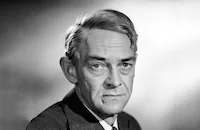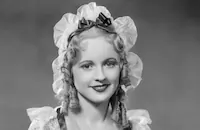No Sad Songs for Me

Brief Synopsis
Cast & Crew
Rudolph Maté
Margaret Sullavan
Wendell Corey
Viveca Lindfors
Natalie Wood
John Mcintire
Film Details
Technical Specs

Synopsis
When Mary Scott learns that she has cancer and has less than a year to live, she asks her doctor, Ralph Frene, not to tell her husband Bradford and daughter Polly. As Christmas approaches, Mary becomes particularly aware of how quickly time is passing, but still does not tell Brad of her illness. On New Year's Eve, Mary and Brad invite Brad's new draftsman, Chris Radna, to attend a party with them. Brad is pleasantly surprised when, for the first time, he sees Chris wearing a beautiful dress, rather than her usual sturdy trousers and jacket. At the party, Brad dances often with Chris, causing some of the women to gossip about them. Realizing that Chris and Brad are falling in love, Mary decides to visit her father in San Francisco, but Mary is unable to tell him about her illness. She later meets an old friend, now a widower, and the woman he is currently dating. Mary's dislike of the woman spurs her to consider what will happen to Brad and Polly after she dies. Mary arrives home and, believing that Brad no longer loves her, considers suicide. Later that evening, Brad tells Mary that he had an affair with Chris, but has ended it and adds that Chris is leaving town. Secretly, Mary visits Chris, who apologizes for her affair with Brad, explaining that her own husband died during the war and, until she met Brad, she had believed that she would never love anyone again. Mary intends for Brad to marry Chris, a woman she likes, after her death and starts to include her in their lives, introducing her to friends and allowing her to make friends with Polly. When Brad accidentally finds Mary's pain pills, he calls Ralph and finally learns of her approaching death. Without telling her, he decides to make the remaining weeks of Mary's life as wonderful as he can. Thanks to his efforts, Mary enjoys a brief idyll with Brad in Mexico before she dies.

Director
Rudolph Maté
Cast

Margaret Sullavan

Wendell Corey

Viveca Lindfors

Natalie Wood

John Mcintire

Ann Doran

Richard Quine
Jeanette Nolan

Dorothy Tree
Raymond Greenleaf
Urylee Leonardos

Harlan Warde
Margo Woode
Harry Cheshire
Douglas Evans
Sumner Getchell

Lucile Browne
Therese Lyon
Mary Alan Hokanson
Michael Barret
Al Eben
Louis Mason
George Bruggeman
Paul E. Burns
Myron Healey
John Berkes
Ted Stanhope
Harris Brown
Marcel De La Brosse
Rita Conde
Miguel Contreras
Hank Patterson
Robert Filmer
Maudie Prickett
Bill Dill
Thomas Kingston
Rube Schaffer
Crew
Buddy Adler
Clay Campbell
Louis Diage
George Duning
Helen Hunt
Howard Koch
Jean Louis
William Lyon
Russell Malmgren
Sam Nelson
Cary O'dell
Robert Parrish
Morris Stoloff
Joseph Walker

Film Details
Technical Specs

Award Nominations
Best Score
Articles
No Sad Songs for Me - No Sad Songs For Me
Columbia Pictures had purchased the rights to Ruth Southard's novel of the same name when it was published in 1944, but the project had languished in pre-production with occasional blurbs in the trades. In 1946, The Hollywood Reporter announced that Casey Robinson had been hired to write the screenplay and produce. Three years later, in 1949, a press release named Sam Wood as director and Irene Dunne as the star. Later that year, when the film went into production, Rudolph Maté became the director, the screenplay was assigned to Howard Koch, and Margaret Sullavan was tapped as the star. For a film that took so long to get started, it had a very short production schedule. No Sad Songs for Me was filmed in one month, from October 13 November 19, 1950, both at the studio and on location in the Los Angeles suburb of Ontario. The cast was rounded out by Wendell Corey as the husband, Viveca Lindfors as the mistress and eleven year-old Natalie Wood as the daughter.
Suzanne Finstad noted in her biography of Wood (Natasha: The Biography of Natalie Wood) that living in a dysfunctional and often violent home helped her become caught up in "her idealized movie family, where she could pretend to be Polly, the cherished daughter of noble cancer victim Margaret Sullavan, who 'was so into her character that it was a little hard to think of her as Margaret Sullavan.' She made a friend of Ann Doran, a respected thirty-something character actress cast as a socialite, who by coincidence would appear in four of Natalie's next films. [...] The self-supporting Doran was on the same treadmill work-wise as Natalie, going from one supporting part to another with barely a breath between. She gave no thought to whether No Sad Songs for Me would be a success, or that it was the first motion picture about cancer. 'What the story was didn't mean a hoot in hell to me. I was only thinking who I was as a character in relation to the other ones.' "
No Sad Songs for Me was released on April 28, 1950 and was hailed by the critics as Margaret Sullavan's picture. Bosley Crowther in his New York Times review of the film lamented that she had been absent from the screen for so long, "and for that there is no excuse. For plainly Miss Sullavan is someone who can give to a needy role the fullness of personality that will bring it to life and form. Plainly she has the rare capacity to imbue with emotion and warmth a modest creation of fiction which might easily be mawkish and chill. [...] To be sure she had been provided with a very good script by Howard Koch a script which is not only literate but which protects the situation with high ideals and Rudolph Maté's direction is crisp and sensitive. And the acting support of her associates especially of Wendell Corey as the spouse is of an accomplished order to match that of Miss Sullavan. [...] Not since Bette Davis played Dark Victory [1939] several years ago has a subject of such peculiar anguish been handled so delicately. Now that Miss Sullavan is back among us, with her glowing smile and her melting voice, let's hope that we'll be seeing her often. And let's hope that next time she doesn't die."
Unfortunately, No Sad Songs for Me was Margaret Sullavan's final film. She spent the last ten years of her life in the theater and making the rare television appearance before her death on January 1, 1960.
Producer: Buddy Adler
Director: Rudolph Mate
Screenplay: Howard Koch; Ruth Southard (novel)
Cinematography: Joseph Walker
Art Direction: Cary Odell
Music: George Duning
Film Editing: William Lyon
Cast: Margaret Sullavan (Mary Scott), Wendell Corey (Bradford 'Brad' Scott), Viveca Lindfors (Chris Radna), Natalie Wood (Polly Scott), John McIntire (Dr. Ralph Frene), Ann Doran (Louise Spears), Richard Quine (Brownie), Jeanette Nolan (Mona Frene), Dorothy Tree (Frieda Miles), Raymond Greenleaf (Mr. Caswell), Urylee Leonardos (Flora, the Maid).
BW-89m.
by Lorraine LoBianco
SOURCES
AFI.com
Film review by Bosley Crowther , The New York Times April 28, 1950
Natasha: The Biography of Natalie Wood by Suzanne FInstad
The Internet Movie Database

No Sad Songs for Me - No Sad Songs For Me
Quotes
Trivia
Notes
This picture marked Margaret Sullavan's last film appearance and her first since Cry Havoc in 1943. According to an January 11, 1944 Los Angeles Examiner news item, Victor Saville was slated to direct the film shortly after Columbia's purchase of the Ruth Southard novel. A August 21, 1946 Hollywood Reporter news item noted that Casey Robinson would produce and write the film, and Irene Dunne would star in it. In June 1949, Hollywood Reporter reported that Sam Wood had been signed to direct the film. Wendell Corey was loaned to Columbia by Hal Wallis' company. Some scenes were shot on location in Ontario, CA, near Los Angeles. George Duning's musical score was nominated for an Academy Award.

Miscellaneous Notes
Released in United States Spring May 1950
Released in United States 1997
Released in United States Spring May 1950
Released in United States 1997 (Shown in New York City (Walter Reade) as part of program "American Romantics: Frank Borzage and Margaret Sullavan" August 22 - September 16, 1997.)














